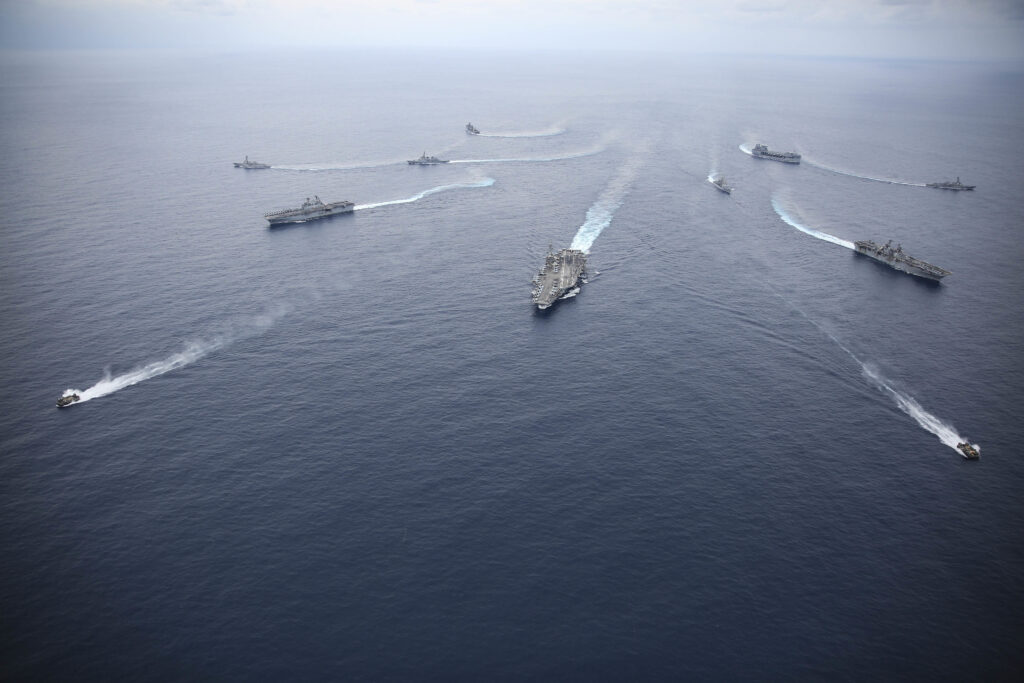
PACIFIC OCEAN — A multi-national and multi-strike group conducted a sweeping series of operations the Western Pacific earlier this month.
Noble Fusion 2022 took place Feb. 3-7, involving two Amphibious Ready Groups with embarked Marine Expeditionary Units along with a Carrier Strike Group. U.S. Army and Air Force units, and units of the Japan Self Defense Forces, also took part.
The exercise was led by Combined Task Force 76/79. According to a Navy statement, Noble Fusion 2022 units operated from “the Luzon Strait to the Miyako Strait and the East China Sea, encompassing a wide swath of the First Island Chain, including littoral areas in the vicinity of Okinawa.”
“For the first time since 2018, two Amphibious Ready Groups with embarked Marine Expeditionary Units conducted operations together in the Indo-Pacific region,” said Navy spokesperson Lt. Cmdr. Sherrie Flippin. “The most recent exercise Noble Fusion highlighted Naval Expeditionary Forces’ capability to rapidly aggregate Marine Expeditionary Unit/Amphibious Ready Group teams at sea with joint force elements, allies and a Carrier Strike Group, in order to conduct sea-denial, seize key maritime terrain, guarantee freedom of movement, and create advantage for U.S., partner and allied forces.”
The exercise commenced with amphibious maneuvers to demonstrate the ability to seize key maritime terrain involving the 11th MEU/USS Essex (LHD 2) ARG and Carrier Strike Group-3’s USS Abraham Lincoln (CVN-72) flying AV-8B Harriers, MV-22B Ospreys and a Navy E-2D Advanced Hawkeye over the Luzon Strait. Abraham Lincoln was escorted by the Arleigh Burke-class destroyer USS Spruance (DDG 111) and the Ticonderoga-class cruiser USS Mobile Bay (CG 53).
Later, the 31st MEU/USS America (LHA-6) ARG conducted strikes in the First Island Chain with F-35B Lightning II fighters. Additionally, F-35B’s of Marine Aircraft Group 12 out of Iwakuni, Japan, as well as F-15C Eagles with the U.S. Air Force’s 18th Wing out of Kadena Air Base, teamed up with a P-8 Poseidon from Task Force 72, to conduct a maritime strike.
“This type of training demonstrates the resilience and interoperability with our joint forces and our partners and allies,” said Col. Michael Nakonieczny, commander of the 31st MEU, speaking to reporters Feb. 16.
“It’s important for us to consider ourselves partners, trying to figure out how we become better warfighters as a combined team,” said Capt. Greg Baker, commodore of Amphibious Squadron 11, who joined Nakonieczny on the call with journalists.
USS Dewey (DDG 105) and JS Kongo (DDG 173) conducted surface operations to protect and defend the force. Commander Destroyer Squadron 7 was the surface warfare commander throughout the exercise.
“Sea-denial operations with cruisers and destroyers, seizing key maritime terrain with aviation and surface movement, guaranteeing freedom of movement — these are the things we do every day in the Indo-Pacific,” said Navy Capt. Tom Ogden, the DESRON 7 commodore. “This exercise validates the ability of U.S. forces and allies to establish sea control and maintain readiness while also providing security and enabling stability.”
Brig. Gen. Kyle Ellison, commanding general, 3rd Marine Expeditionary Brigade and CTF-79 commander, said Noble Fusion 2022 was about using the sea as maneuver space to achieve positional advantage.
“It was about exercising our ability to maneuver critical capability to locations in the time and space of our choosing,” Ellison said. “We achieved positional advantage with the integration of two ARGs with their associated MEUs enabled by a carrier strike group. These capable warships must remain a critical component of our integrated deterrence strategy. Rest assured, we proved as an integrated, naval, joint and allied force that we are completely committed to a free and open Indo-Pacific region. We are effectively contributing to that goal now and our operational prowess will only improve.”
The capstone event was a night strike in the First Island Chain by F-35C Lightning II aircraft from Lincoln and AV-8B Harriers from Essex, along with F-18E Super Hornets acting as an aggressor force. Night aerial refueling supported the strike, with 11th MEU AV-8B Harrier attack aircraft being refueled by KC-130J Hercules aircraft of Marine Aircraft Group 12.
“Noble fusion has been an incredible opportunity to rapidly, and at a time and place of our choosing, demonstrate that when our allies and U.S. joint forces come together, we are the premier fighter force in the region,” said Rear Adm. Chris Engdahl, commander of Expeditionary Strike Group 7/Task Force 76. “Seamlessly integrating our advanced platforms alongside our professional staffs at sea and ashore allowed us the chance to reinforce our command and control in the air, on the ground, at sea, and below the surface.”
- A Day to Remember - September 11, 2023
- Indo-Pacific Maritime Security Exchange will examine emerging capabilities and capacity - July 12, 2023
- Cold Waters Spark Warm Relationship - April 20, 2023






